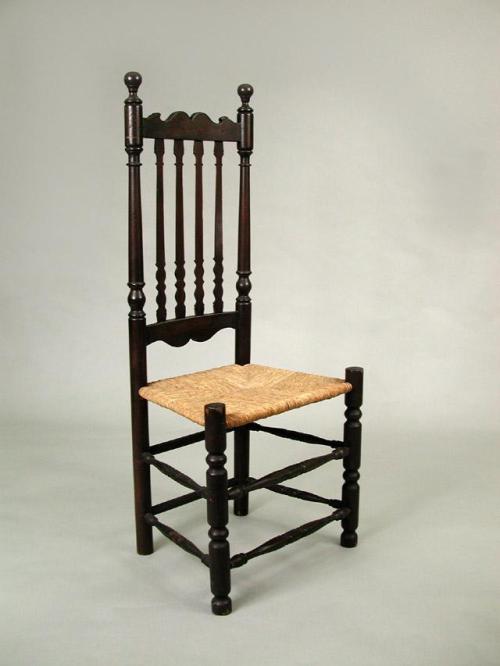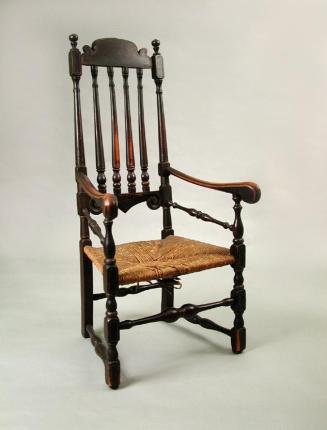Side Chair
Furniture MakerMade by
Unknown
Date1860-1890
MediumBlack walnut, rush
DimensionsPrimary Dimensions (overall height x width x depth): 46 1/4 x 19 11/16 x 15 1/4in. (117.5 x 50 x 38.7cm)
ClassificationsFurniture
Credit LineMuseum purchase
Object number1983.118.0
DescriptionWalnut side chair with a solid crest rail, bannister back, turned stiles, bannisters, legs and stretchers, and a rush seat. The chair is in the William and Mary, or early baroque, style, but it was made in the late nineteenth century. The back of the chair is formed by a crest rail at the top between two turned stiles; each stile has a ball-shaped finial at the top. The top of the crest rail is shaped with two raised half circles in the center, with a small spur to each side. Below the crest rail are four cone-and-reel turned banisters, which attach at the bottom to the stay rail. The banisters are turned and split; the rounded side of each banister faces the back of the chair. The lower edge of the stay rail is shaped with a cyma curve, or S-curve, and reverse cyma curve. Above the seat, each stile has cone-and-reel turnings. Below the seat, each stile forms a cylindrical back leg and foot. Each front leg is turned with three cylindrical sections, each separated by a ring, over a cylindrical foot. Each front leg has a flat top that extends slightly higher than the rush seat, which is trapezoidal in shape. The front and both sides of the chair each have two stretchers turned with double-baluster-and-ring forms. There is one plain turned stretcher in the back. The chair has an overall dark brown finish.
Condition: The chair has been disassembled. The top front stretcher is replaced; both front stretchers are worn. There is artificial wear on the back of each stile and finial. The chair is refinished.
Design and Construction Details: The crest rail has a rectangular tenon at each side that extends into the cylinder near the top of each stile; this joint is secured with a wooden pin through the back of the stile. The crest rail is bowed back slightly; the back of the crest rail has a rounded surface. Each banister is constructed of a split spindle. Each banister is tenoned into the crest rail at the top and into the stay rail below. The stay rail has a rectangular tenon at each side that extends into the stiles; this joint is secured with a wooden pin through the back. The stay rail is also bowed back slightly; the back of the stay rail has a rounded surface. The seat rails are plain and turned. The seat rails and stretchers have round tenons that extend into the front or back legs. The upper and lower stretchers on all four sides of the chair are at the same level. Faint grooves circling the stiles and the front legs mark the placement of the crest rail, stay rail, seat rails, and stretchers. Each seat rail is bladelike, with a rounded outer edge and a tapered inner edge. The seat rails and stretchers have round tenons that extend into the front or back legs.
Condition: The chair has been disassembled. The top front stretcher is replaced; both front stretchers are worn. There is artificial wear on the back of each stile and finial. The chair is refinished.
Design and Construction Details: The crest rail has a rectangular tenon at each side that extends into the cylinder near the top of each stile; this joint is secured with a wooden pin through the back of the stile. The crest rail is bowed back slightly; the back of the crest rail has a rounded surface. Each banister is constructed of a split spindle. Each banister is tenoned into the crest rail at the top and into the stay rail below. The stay rail has a rectangular tenon at each side that extends into the stiles; this joint is secured with a wooden pin through the back. The stay rail is also bowed back slightly; the back of the stay rail has a rounded surface. The seat rails are plain and turned. The seat rails and stretchers have round tenons that extend into the front or back legs. The upper and lower stretchers on all four sides of the chair are at the same level. Faint grooves circling the stiles and the front legs mark the placement of the crest rail, stay rail, seat rails, and stretchers. Each seat rail is bladelike, with a rounded outer edge and a tapered inner edge. The seat rails and stretchers have round tenons that extend into the front or back legs.
Status
Not on view












